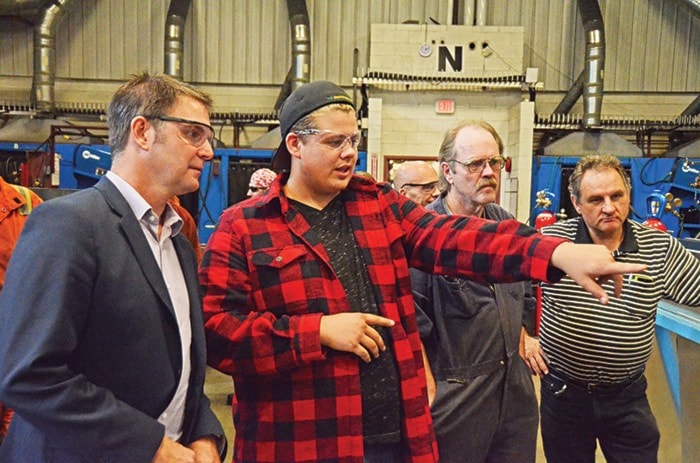North Island College (NIC) has unveiled $187,000 worth of new equipment which it says will help them prepare trades students for their future careers.
The announcement on Tuesday afternoon at NIC’s Campbell River campus was the part of a $561,000 funding investment by the provincial government for trades equipment at that facility, Camosun College in Victoria and Vancouver Island University in Nanaimo.
“I haven’t taken a trades class since about 1984, and I got a C- on my wood shop bookcase – although my mom still has it in a place of honour,” jokes Comox Valley MLA Don McRae, addressing a group of students Tuesday. “So I look forward to getting bills from you in the future as you go into the private sector, because I break things but I don’t fix them myself.”
McRae says it is important to fund training initiatives in regions like Campbell River so that students can study where they want to live – or where they grew up and would like to continue living – instead of relocating to get their education.
“This a beautiful place to live, and going to school can be expensive, so if we can train people close to home for jobs that hopefully can be close to home, it gives you opportunities to stay in your communities, raise families, and have a great quality of life.”
Cheryl O’Connell, NIC’s dean of trades and technical programs, says this funding is the result of the school constantly identifying priorities in their capital equipment needs and pitching them to the government.
“The government identifies a budget allocation and they have us present a proposal about what our priorities are when it comes to capital equipment considerations,” O’Connell says. “It’s a bit of a negotiation, and we’re needing to justify why replacement or why new product, and it absolutely has to align with curricular considerations. There are no frivolous purchases.”
The majority of the these pitches to the government involve requesting the replacement of equipment that has simply worn out through regular use, O’Connell says.
“That’s common for most post-secondary institutions, because, as you can probably imagine, if you have two cohorts or four cohorts per year of 16 students, that equipment does wear and tear quite quickly, so we do have our priority allocation being replacement,” O’Connell says. “But then there are also new, leading-edge technologies we are able to pursue.”
One example of that is the new metal shear unveiled Tuesday in the welding shop.
The new computerized shear cuts metal up to a half inch thick in sheets up to 10 feet long.
Other equipment purchased with the new funding included drill presses and a new sub arc welding system.
Newer models of truck – like the 2008 and 2009 Freightliner refrigeration trucks also purchased with the most recent funding – have different transmissions and fuel systems, according to director of trades and technical programs Chris Udy, so it’s important to get the students working on those systems before they get out into the workforce.
“We went through a period of time when we didn’t have the most modern support training aids for the students,” Udy says, “so the investment the government has made over the last three or four years has been quite substantial for our institution.”
Welding student Darren Smith agrees.
“It means when I get out of the course and go into the industry, I can work on what the industry is using rather than trying to teach myself new concepts,” Smith says.
The old metal shear the school just replaced, for example, “cut the metal fine, but it’s definitely not what the industry is using anymore. I did work experience at a welding shop in Courtenay, and they just got new equipment like what we’re using now, and if I hadn’t been using this one, I would have gone in there, looked at it all starstruck and have had to ask for help instead of just going in, punching in some numbers and going away,” Smith says.
“It’ll be super helpful for getting a job.”
